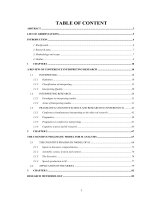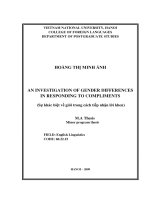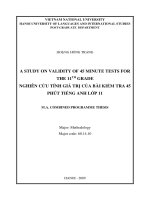an investigation of the polysemy of open close' in english and mở đóng in vietnamese (from the cognitive perspective) = nghiên cứu tính đa nghĩa của động từ mở đóng trong tiếng anh và tiếng việt t
Bạn đang xem bản rút gọn của tài liệu. Xem và tải ngay bản đầy đủ của tài liệu tại đây (548.97 KB, 7 trang )
VIETNAM NATIONAL UNIVERSITY, HANOI
UNIVERSITY OF LANGUAGES AND INTERNATIONAL STUDIES
FACULTY OF POST - GRADUATE STUDIES
BÙI THỊ NGỌC
AN INVESTIGATION OF THE POLYSEMY OF ‘OPEN/CLOSE’
IN ENGLISH AND ‘MỞ/ĐÓNG’ IN VIETNAMESE
(FROM THE COGNITIVE PERSPECTIVE)
(NGHIÊN CỨU TÍNH ĐA NGHĨA CỦA ĐỘNG TỪ ‘MỞ/ĐÓNG’
TRONG TIẾNG ANH VÀ TIẾNG VIỆT NHÌN TỪ GÓC ĐỘ
NGỮ NGHĨA HỌC TRI NHẬN)
M.A. Minor Thesis
Field: English Linguistics
Code: 60 22 15
Hanoi, 2010
VIETNAM NATIONAL UNIVERSITY, HANOI
UNIVERSITY OF LANGUAGES AND INTERNATIONAL STUDIES
FACULTY OF POST - GRADUATE STUDIES
BÙI THỊ NGỌC
AN INVESTIGATION OF THE POLYSEMY OF ‘OPEN/CLOSE’
IN ENGLISH AND ‘MỞ/ĐÓNG’ IN VIETNAMESE
(FROM THE COGNITIVE PERSPECTIVE)
(NGHIÊN CỨU TÍNH ĐA NGHĨA CỦA ĐỘNG TỪ ‘MỞ/ĐÓNG’
TRONG TIẾNG ANH VÀ TIẾNG VIỆT NHÌN TỪ GÓC ĐỘ
NGỮ NGHĨA HỌC TRI NHẬN)
M.A. Minor Thesis
Field: English Linguistics
Code: 60 22 15
Supervisor: Assoc. Prof. Dr. Trần Hữu Mạnh
Hanoi, 2010
4
TABLE OF CONTENTS
PART A: INTRODUCTION 1
1. RATIONALE OF THE STUDY 1
2. SCOPE OF THE STUDY 1
3. OBJECTIVES OF THE STUDY 1
4. RESEARCH QUESTIONS 2
5. ORGANIZATION OF THE STUDY 2
PART B: DEVELOPMENT 4
CHAPTER I: LITERATURE REVIEW 5
1.1. AN OVERVIEW ON CONTRASTIVE ANALYSIS 5
2.2. A BRIEF DESCRIPTION OF VERBS 7
2.2.1. Verbs in English 7
2.2.2. Verbs in Vietnamese 8
3.3. COGNITIVE LINGUISTICS 9
3.3.1. Definition of terms 9
3.3.2. Major principles of cognitive linguistics 10
3.4. COGNITIVE SEMANTICS 10
3.4.1. Definition 10
3.4.2. Guiding principles of cognitive semantics 11
3.5. POLYSEMY 13
3.5.1. The traditional treatment of polysemy 13
3.5.2. Polysemy in cognitive linguistics 14
3.5.3. Summary 15
CHAPTER 2: METHODOLOGY 16
2.1. RESEARCH QUESTIONS 16
2.2. RESEARCH DESIGN AND METHOD 16
2.3. METHOD AND SOURCES OF THE LANGUAGE MATERIAL 17
2.3.1. Sources of the language material 17
5
2.3.2. Method of data collection 18
2.4. ANALYTICAL FRAMEWORK 18
CHAPTER 3: DATA ANALYSIS 20
3.1. THE POLYSEMY OF OPEN/CLOSE IN ENGLISH 20
3.1.1. Prototypical and non-prototypical meanings of ‘open/close’ 20
3.1.1.1 .Physical meanings of ‘open’ and ‘close’ 20
3.1.1.1.1. Physical meanings of the verb ‘open’ 20
3.1.1.1.2. Physical meanings of the verb ‘close’ 21
3.1.1.2. Non-prototypical extended meanings of ‘open/close’ 22
3.1.1.2.1. Non-prototypical extended meanings of the verb ‘open’ 22
3.1.1.2.2. Non-prototypical extended meanings of the verb ‘close’ 24
3.1.1.3. Summary 25
3.1.2. Encyclopaedic knowledge and meanings of ‘open/close’ 26
3.1.3. Radial category of ‘open/close’ 29
3.2. THE ENGLISH VERBS ‘OPEN/CLOSE’ AND THEIR VIETNAMESE
EQUIVALENTS 30
3.2.1. ‘Open/close’ in English corresponds to ‘mở/đóng’ in Vietnamese 31
3.2.1.1. ‘Open’ in English corresponds to ‘mở’ in Vietnamese 31
3.2.1.2. ‘Close’ in English corresponds to ‘đóng’ in Vietnamese 32
3.2.2. Some other Vietnamese equivalents of the English verbs ‘open/close’ 33
3.2.2.1. Some other Vietnamese equivalents of the English verb ‘open’ 33
3.2.2.1. Some other Vietnamese equivalents of the English verb ‘close’ 35
3.3. SIMILARITIES AND DIFFERNENCES BETWEEN ‘OPEN/CLOSE’ IN ENGLISH
AND ‘MỞ /ĐÓNG’ IN VIETNAMESE 37
3.3.1. Similarities 37
3.3.2. Differences 39
3.4. SUMMARY 39
PART C: CONCLUSION 41
6
1. CONCLUSIONS 41
2. IMPLICATIONS 42
3. LIMITATIONS OF THE RESEARCH AND SUGGESTIONS FOR FURTHER
STUDY 43
REFERENCES 44
3
ABSTRACT
The overall aim of this research is to advance an understanding of polysemy in the semantic
field of the two verbs open and close in English and Vietnamese from cognitive perspective.
Specifically, a review of all related theoretical foundation is done in the first chapter, serving
as a background for the study to be carried out in the rest of the part. Particularly, the first
chapter displays my understanding of contrastive analysis, verbs, cognitive linguistics,
cognitive semantics and polysemy.
Chapter 2 – Methodology – describes the methods and the research procedures of the current
study. Particularly, it describes the data collection in which considerations in selecting
materials and the sources of data are presented. Additionally, a description of data analysis is
also presented.
Chapter 3 – Data Analysis– contains the core part of the study. It presents, analyzes and
synthesizes data collected. This chapter applies the theoretical framework that is established
in chapter 2 into analyzing the meanings of the two verbs open/close and find out
Vietnamese equivalents of these English verbs. Although there appear to be some differences
in the meanings and in the way in which these languages express meanings, especially
different non-prototypical extended meanings, these two languages share the majority of
them. And although the same meanings are expressed in different languages, the way in
which these different languages convey such meanings can be different.
Accordingly, our findings are supposed to be worthwhile to those who are interested in the
field of cognitive semantics in general and polysemy in particular.
PDF Merger
Thank you for evaluating AnyBizSoft PDF
Merger! To remove this page, please
register your program!
Go to Purchase Now>>
Merge multiple PDF files into one
Select page range of PDF to merge
Select specific page(s) to merge
Extract page(s) from different PDF
files and merge into one
AnyBizSoft









